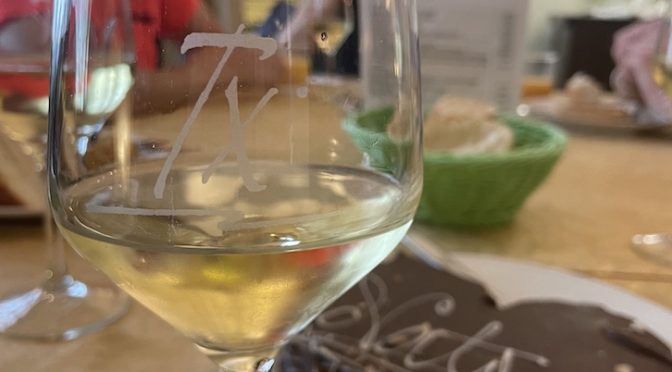One of the unique pleasures of the Basque Country is all of the wonderful tastes it has to offer. I’ve written about some of the unique drinks you can find only in the Basque Country. Txakolin, or txakoli as it is more commonly known, is perhaps the most well known, having found its way across the globe. We were even able to find it in our local liquor store here in Santa Fe! Our last stop in our visit to the Basque Country before getting on the plane was El Txakoli, where we toasted to an amazing trip! Here’s to the next one!

- According to the Real Academia, txakolin is a “Light, somewhat sour wine that is made in the Basque Country, Cantabria and Chile.” It is a dry white wine that has a high acidity and low alcohol content.
- Historically, it was called txakolin wine – it was Sabino Arana who proposed, roughly in 1895, to drop the n and call it txakoli. Though vineyards in the Basque Country are attested from Roman times, the first historical mention of txakolin dates to 1520.
- There is one apocryphal anecdote about the origins of the name, as told to Basque ethnologist José Uría Irastorza by an old Txakolinero – someone who makes txakolin. Supposedly, when the winemaker was asked “How much wine have you made?” it was customary to respond: “Etxeko ain,” that is, just enough for home. From “etxeko ain” it became “etxekolain” and ended up being called “txakolin.”
- The alcohol content of txakolin is only about 7%, about 2% too little to formally be called wine. However, the Estatuto de la Viña of 1970 made txakolin an exception, allowing the relatively weaker drink to be called wine.
- There are essentially two variants of txakolin. Historically, txakolin wine was made from grapes that simply weren’t good enough for anything else. They may have been damaged by hail, for example, or just were of bad quality. This wine was despairingly compared to vinegar. However, modern txakolin is made from specific strains of grapes grown under specific climate and land conditions. It has even received a Denomination of Origin.
- In past times – we are talking of the 1400s or even before – no other wine could be imported or sold in the province of Gipuzkoa until all of the txakolin wine had been consumed. This protected the local production from outside competition. However, the wine was considered so “thin and weak” and “raw” by the clergy that it was banned from being used in Catholic mass. Further, some Basques considered the txakolin wines so bad that in 1584 they petitioned to have the rule against importing other wines overturned, saying even the owners of the vineyards didn’t want to drink their own wine.
- The most common varieties of grapes used in making txakolin are the Hondarrabi Zuri (between 85-90% of strains) and Hondarrabi Beltza (between 10-15%). In Bizkaia, Folle Blanche are also used. These strains are only found along the Basque coast and in Béarn, in France.
- The grapes, once pressed, were given to animals for feed, but this had to be done relatively quickly so as to prevent fermentation and making the animals drunk.
- Txakolin is a magnificent aperitif: its acidity stimulates the production of saliva and the secretion of gastric juices, preparing the body for better digestion. It also aids in the assimilation of proteins (meat, fish, etc.) thanks to its ionic acidity and its weak osmotic pressure.
Primary sources: Aguirre Sorondo, Antxon. Txakoli. Auñamendi Encyclopedia. Available at: https://aunamendi.eusko-ikaskuntza.eus/en/txakoli/ar-132636/; Txakoli, Wikipedia



Greetings,
What is the name of the wine store in Santa Fe? Thank you. Monique
It is Kelly’s Liquor Barn on Cerillos.